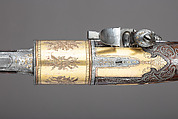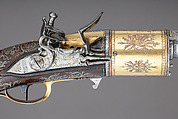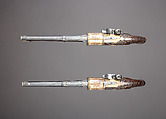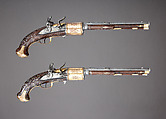Returned to lender The Met accepts temporary loans of art both for short-term exhibitions and for long-term display in its galleries.
Pair of Flintlock Revolvers
Manufacturer Tula Arms Factory Russian
Not on view
Multi-shot firearms with revolving cylinders appeared in Europe around 1600, more than two centuries before Samuel Colt invented his famous revolver. From the earliest days of hand-held firearms, sixteenth-century gunmakers sought to improve the speed and effectiveness of single-shot, muzzle-loading firearms, which were slow to load, subject to misfiring, and often inaccurate. Firearms offering two or more shots therefore provided considerable advantages on the battlefield and in the hunt. The earliest solution, wheellock guns and pistols fitted with two or more barrels and locks, proved to be heavy and cumbersome to use. The revolver, on the other hand, was an ingenious solution that offered multiple shots requiring only a single lock mechanism. However, the engineering of the revolver mechanism, particularly the alignment of the cylinder’s chambers with the barrel, required a precision that often eluded gunmakers, sometimes with disastrous results. Revolvers would remain experimental until the nineteenth century, when machine-made parts assured reliable and effective mechanisms.
The present pistols are an exceptionally rare late eighteenth-century example of revolving flintlock pistols made in the imperial Russian Arms Factory at Tula. Founded by Peter the Great in 1712, the Tula factory produced both plain military arms and deluxe hunting weapons for personal use by the imperial family and members of the court, as well as for diplomatic gifts. Made around 1790, this pair is distinguished by smoothbore barrels etched to imitate the whorl patterns of "Damascus" (pattern-welded) steel, and gilt copper-alloy cylinders and mounts engraved with trophies of arms, scrolls, and beaded ornament typical of the fashionable neoclassical style of the time. The walnut stocks, on the other hand, are inlaid flush with a delicate floral scrolls and shell motifs in fine silver wire that recall the exuberant rococo style that dominated Russian court tastes several decades earlier. The lockplate of each pistol is engraved with trophies and scrolls inlaid with gold and silver, with a cartouche inscribed in Cyrillic, TULA.
These pistols belong to an unusual garniture comprising of at least three revolving firearms made for a member of the imperial family during the reign of Empress Catherine II (Catherine the Great, ruled 1762–96), for which a matching six-shot fowling piece is still in the former imperial armory in the State Hermitage Museum in Saint Petersburg (inv. no. Z.O.51350).
Fine firearms from Tula are exceptionally rare outside Russia. This pair complements a richly embellished pair of single-shot flintlock pistols made in Tula in 1801 for Grand Duke Constantine of Russia (1779–1831) that were recently acquired by The Met (acc. no. 2018.755.1, .2) and that are currently on display in Gallery 375.
Due to rights restrictions, this image cannot be enlarged, viewed at full screen, or downloaded.
This artwork is meant to be viewed from right to left. Scroll left to view more.








